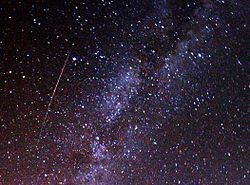Perseid meteor shower
| Perseids (PER) | |
|---|---|

A long, multicolored 2009 Perseid streaks across the sky, just to the left of the Milky Way.
|
|
| Pronunciation | /ˈpərsiːɪdz/ |
| Discovery date | 36 CE (first record) |
| Parent body | Comet Swift–Tuttle |
| Radiant | |
| Constellation | Perseus |
| Right ascension | 03h 04m |
| Declination | +58° |
| Properties | |
| Date of peak | August 12(July 23–August 20) |
| Velocity | 58 km/s |
| Zenithal hourly rate | 80 |
The Perseids /ˈpərsiːɪdz/ are a prolific meteor shower associated with the comet Swift–Tuttle. The Perseids are so called because the point from which they appear to come, called the radiant, lies in the constellation Perseus. The name derives in part from the word Perseides (Περσείδες), a term found in Greek mythology referring to the sons of Perseus.
The stream of debris is called the Perseid cloud and stretches along the orbit of the comet Swift–Tuttle. The cloud consists of particles ejected by the comet as it travels on its 133-year orbit. Most of the particles have been part of the cloud for around a thousand years. However, there is also a relatively young filament of dust in the stream that was pulled off the comet in 1865, which can give an early mini-peak the day before the maximum shower. The dimensions of the cloud in the vicinity of the Earth are estimated to be approximately 0.1 astronomical units (AU) across and 0.8 AU along the latter’s orbit, spread out by annual interactions with the Earth’s gravity.
The shower is visible from mid-July each year, with the peak in activity between 9 and 14 August, depending on the particular location of the stream. During the peak, the rate of meteors reaches 60 or more per hour. They can be seen all across the sky; however, because of the shower’s radiant in the constellation of Perseus, the Perseids are primarily visible in the Northern Hemisphere. As with many meteor showers the visible rate is greatest in the pre-dawn hours, since more meteoroids are scooped up by the side of the Earth moving forward into the stream, corresponding to local times between midnight and noon, as can be seen in the accompanying diagram. While many meteors arrive between dawn and noon, they are usually not visible due to daylight. Some can also be seen before midnight, often grazing the Earth’s atmosphere to produce long bright trails and sometimes fireballs. Most Perseids burn up in the atmosphere while at heights above 80 kilometres (50 mi).
...
Wikipedia
